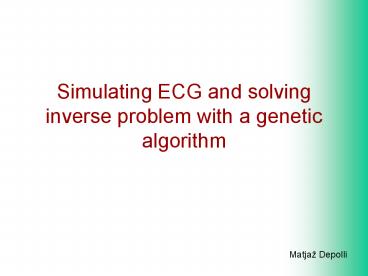Simulating ECG and solving inverse problem with a genetic algorithm - PowerPoint PPT Presentation
1 / 21
Title:
Simulating ECG and solving inverse problem with a genetic algorithm
Description:
Electric charge of a cell responds to an external signal (change of electric ... Three distinct layers of cells (endocard, mid-cells, epicard) ... – PowerPoint PPT presentation
Number of Views:244
Avg rating:3.0/5.0
Title: Simulating ECG and solving inverse problem with a genetic algorithm
1
Simulating ECG and solving inverse problem with a
genetic algorithm
Matja Depolli
2
Topics
- Electrical properties of myocardium (muscular
tissue of the heart) - An ECG
- ECG simulation
- Inverse problem
- Optimization and differential evolution
- Achievements
- Goals and future work
3
ECG
4
Heart anatomy
5
Action potential
- Property of a single cell
- Electric charge of a cell responds to an external
signal (change of electric charge of neighbouring
cell) - A way of transmitting order to contract across
the whole heart muscle
6
Heart model
Action potentials
AV node
7
Heart model
- Three distinct layers of cells (endocard,
mid-cells, epicard) - Simplified Purkinje fibers (transmit signal along
the wall) - Simplifications shape, constant wall width,
uniform properties of all cells of the same
layer, ignored some conductive paths within the
heart
8
ECG leads (electrodes)
9
Simulated ECG
10
Inverse problem
Action potentials
ECG
Parameters
Inverse problem
11
Inverse problem
- Typically ill-posed
- solution might not exist
- more than one solution
- solution(s) might not depend continuously on the
data - solution might be highly sensitive to changes in
data
yf(x)
xg(y)
12
Inverse problem
- Sensitivity of solution to changes in data
- quantization error (finite precision)
13
ECG ? APs
- Solution exists
- Expect more than one solution
- Expect very different solutions (expressing
different mechanisms of U wave genesis) - Solutions not sensitive to small perturbations of
data - Measured ECGs vary, but solutions should be the
same.
14
Optimization
- A typical way of handling inverse problems
- Optimization is an inverse problem
- Optimization of distance between the function
value and desired value
yf(x)
yf(x)-y1
15
Differential evolution
- Optimization of functions with real parameters
- Steady state evolutionary algorithm
- C X1 F(X2 - X3)
C
16
Differential evolution
- No background knowledge of the problem is needed
- Small number of parameters
- Multiple solutions per run
- Easily parallelizable
17
Differential evolution
- Mapping on the presented problem
- Fitness function similarity between the
simulated and measured ECG (curve matching) - Action potentials are modeled with analytic
functions with real-valued parameters
1
2
3x
3
4
18
Achievements
Inside
Outside
1
2
3
4
5
6
7
8
9
10
11
12
19
Achievements
- Learned a lot about the problem
- A new mechanism of U wave genesis was found
(article published in Journal of Cardiovascular
Electrophysiology) - In-vivo measurements taken into account
20
Goals
- A general algorithm for efficient solving of
inverse problems (like the problem of U wave
genesis) - Improvements on the simulator
- including more parameters
- increasing ability to simulate ECG genesis
- ability to simulate defective heart
21
Future work
- Improving models simulator
- Improving the search algorithm
- Improving the fitness function
- Parallelize algorithms
- Putting more parameters in optimization process































